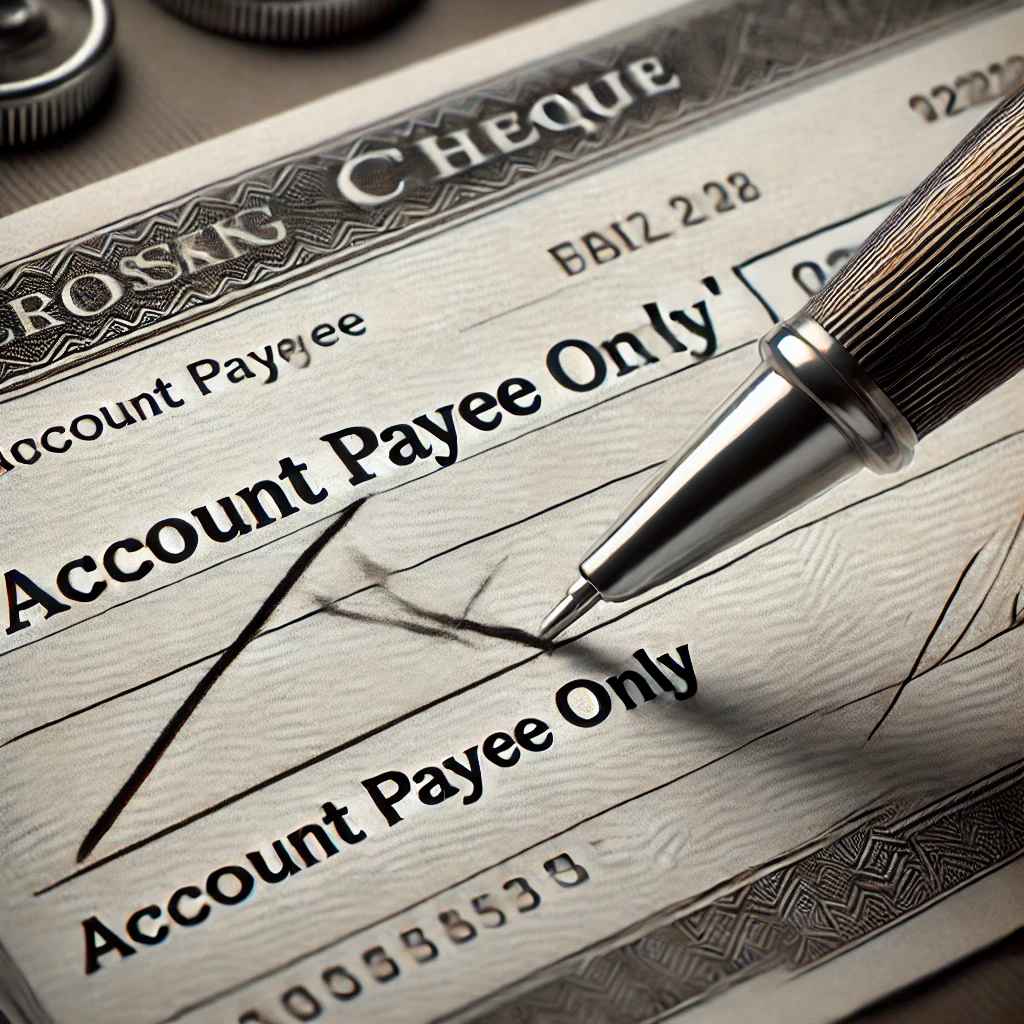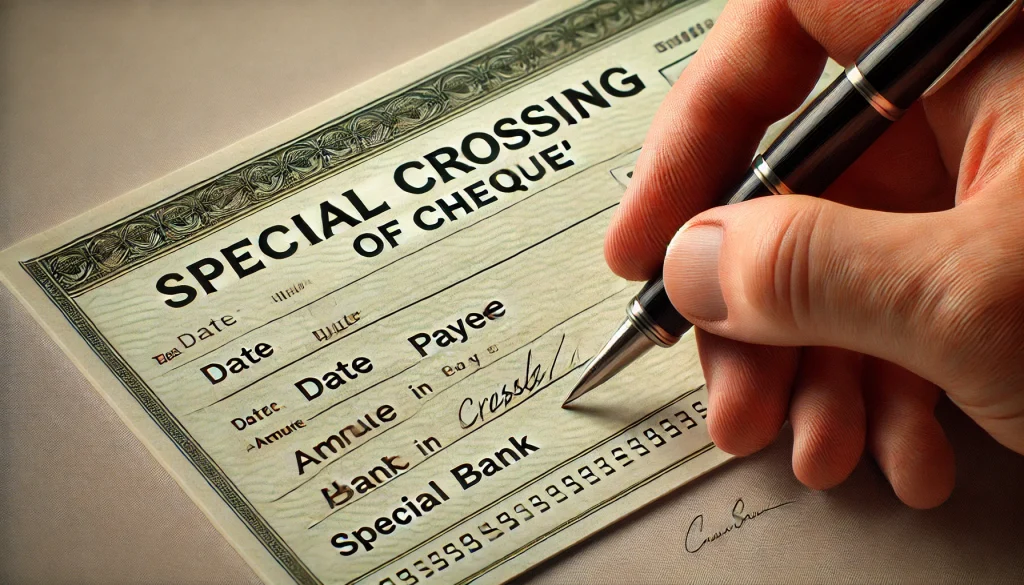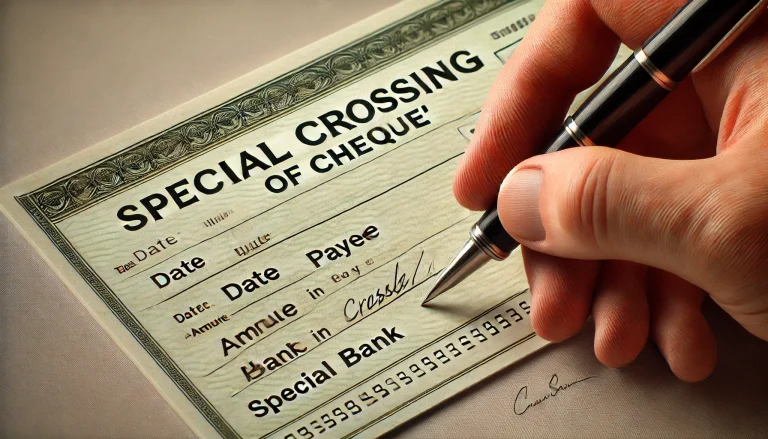A crossing cheque is a type of cheque that uses improved security features, which are normally marked with two parallel lines at the face of the cheque. These lines ensure that the cheque is passed solely through a bank account. A special crossing cheque allows the payment to be made through a particular bank. This ensures that with the outlined bank, the cheque is deposited into the payee’s account thereby giving it a higher degree of security and reliability.
What is Crossing Cheque?
A crossing cheque is a standard cheque with two parallel lines drawn across its face. These lines reveal that the cheque cannot be encashed over the counter. It has to be deposited into a bank account. Crossing cheques prevents their misuse by undesirable people if they get lost or stolen.
There exist various types of crossing checks, that is, general, special, restrictive, and non-negotiable crossing cheques. All these provide different degrees of security and restrictions as to the processing allowed concerning the cheque.

Types of Crossing Cheques
The crossing of cheques is done in several ways, each adding a distinct layer of security:
General Crossing
A general crossing only implies two parallel lines on the cheque and no mention of the bank, which means that the cheque should reach the bank but can be presented by any bank. There is no restriction that which bank can clear the cheque.
Below the lines, one can include words such as “& Co.” or “A/C Payee” that ensure that the cheque cannot be cashed directly and must be received in the payee’s account.
Special Crossing
Two parallel lines are present in a special crossing cheque with the name of a specific bank written between those two parallel lines. It means that this cheque can only be deposited in the account held with the mentioned bank. It adds another layer of security by preventing the cheque from being presented to any other bank other than the one specified in the crossing.
There is one key feature of the instrument, which is that the title of a bank must be included, thereby confining the presentation of the cheque to the bank alone.
Restrictive Crossing
In restrictive crossing, the approach is then advanced to ensure the safety of the cheque through proof that a cheque can only be lodged into the payee’s account. With a cheque stamped “Account Payee Only,” it cannot be passed to another party for endorsement. Thereby, reducing the scope of fraudulent transfer.
The cheque is not negotiable, and it offers security that it will only be credited into the account of the payee endorsed within the cheque being an individual or organization.
Non-Negotiable Crossing
A crossing cheque contains a “non-negotiable” on it so that it cannot be endorsed or forwarded to any person. This crossing is especially used when the cheque is issued for a specific purpose, and hence transferability needs to be restricted. The cheque carries “Not Negotiable” marked over it, which essentially means that the cheque cannot be transferred to another person to initiate a new transaction process.

What is Special Crossing Cheque?
A special crossing cheque is the most frequent kind of crossing cheque, which clearly writes a specific name of a bank between the two running parallel lines. This type of crossing is specifically intended to increase the security level of cheque transactions. Under this type of crossing, the payment is only allowed to be collected by the payee from the bank whose name falls between the running parallel lines of crossing. Therefore, this cheque cannot get deposited in any other bank and provides extra security to avail services through this cheque that are possible only by the designated bank.
For example, while issuing a cheque with special crossing with “Bank of XYZ,” then only the account held in Bank of XYZ can clear the cheque.
Features of Special Crossing Cheque
The key features of a special crossing cheque include:
- Bank-Specific: Only the crossing names would be permitted to clear such cheques.
- Higher safety: As it is the same cheque to be presented for deposit with the banker with the mentioned bank, thus making it safer from fraud or misuse.
- Not transferable: Sometimes, the special crossing can be used along with “Account Payee” instructions and makes the cheque not transferable to a third party or organization.
- Clear Instructions: The drawee has an upper hand in controlling the process of where and how the cheque is finally processed, thus less possibility to handle an error in case the cheque is lost.
Example of Special Crossing:
A firm draws a cheque on the supplier and crosses it with “Bank of India.” This way, even if the supplier banks somewhere else, it can cash such a cheque only at Bank of India.
How to Special Crossing Cheque
It is a straightforward procedure in the creation of special crossing cheques; however, handling it with care is essential to validate the cheque as well as the security features coupled with it. Here is how you shall put the special crossing on a cheque:
- Draw Two Parallel Lines: Draw two parallel lines across the cheque on the left top corner of it.
- Name of the Bank: While writing the name between the lines, mention the name of the bank. Suppose you want a cheque to be processed by the State Bank of India. So, you have to write “State Bank of India” on the middle line.
- Additional Safety Features: As an added safety, you may enclose your words “Account Payee Only” below the name of the bank to ensure that the money gets credited to the payee’s account only.
Crossing cheques is an essential tool used to ensure the security of the financial transaction process. Of the various kinds of crossings, a special crossing cheque provides additional security because it designates a specific bank for clearance. This renders the cheque unsafe for misuse and narrows the scope for misappropriation.
Special Crossing Cheque FAQs
What is the difference between a general crossing cheque and a special crossing cheque?
A general crossing cheque can be cleared through any bank, while a special crossing cheque can only be cleared through the bank specified in the crossing.
Can a special crossing cheque be transferred?
No, a special crossing cheque, especially when marked “Account Payee Only,” cannot be transferred to another party.
How does restrictive crossing work?
A restrictive crossing ensures that the cheque can only be credited to the payee’s account and not endorsed to someone else.
Why is special crossing important?
Special crossing enhances the security of cheque transactions by ensuring the cheque is processed through a specific bank only.
What is the safest type of cheque crossing?
The combination of a special crossing and “Account Payee Only” marking is considered one of the safest, as it ensures both bank-specific processing and direct credit to the payee’s account.


